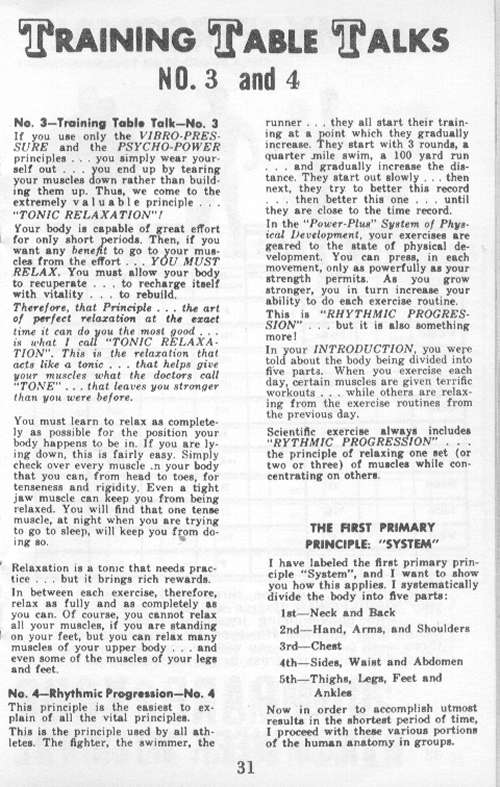73750 vibro 31

^pRAINING ITaBŁE 1*ALKS
NO. 3 and 4
No. 3—Troining Tobla Talk—No. 3
If you u»r only thr V'IRRO-PRES-SURE and the PSYCHO-POWER principle# . . . you simply w«r your aelf out . . . you end up by teanng your mu*clea down rather than build-mg them up. Thua, wc comc to the extremely v a I u a b l e principle . . "TONIC RELAXA TlON"f Your body ia capable of great efTort for only ahort oerioda. Then, if you want any beneftt to go to your mua-cle* from the efTort . . . YÓU MU ST RELAX. You muat allow your body to recuperate ... to recharge itaelf with vitality . . to rebuild. Therefore. that Principle . . . the art of perfeet relaxation nt the exaet lim# it ean do you the mo»t good . . . .* uhat I raił "TONIC RELAXA TION". Thie i* the relaration that acte like a tonie . . . that helpe give your tuuscle* what the doctor s cali “TONĘ" . . . that leavex you Mtronger than you were before.
You muat learn to relax aa complcte-ly aa poaaible for the position your body happen* to b<- in If you are ly-mg down, thia ia fairly eaay. Simply check over every muacle .n your body that you can, from head to toea, for tcnaeneaa and rigidity. Even a tight jaw muacle can keep you from bcing relaxed. You will find that one tenae rnusclc, at night when you are trying to go to aleep. will kcep you from do-ing *o.
Kelaxation ia a tonie that need* prac-tico . . , but it bringa rich rewarda.
In between cach cxerci*e, therefore, rclax aa fully and aa completely aa you can. Of courae, you cannot relax all your muacle*, if you are atanding on your feet, but you can relax many muaclea of your upper body . . and
even some of the muaclea of your lega and feet.
No. 4— Rhythmic Progrataion—No. 4
Thia principle is the eaaicet to ex-plain of all the vital principle*.
Thia ia the principle uaed by all ath-letea. The flghter, the iwimmer, the
runner . . they all start their tram-
ing at a point which they gradually incrcaac. They atart with 3 rounda, a quarter mile awim, a 100 yard run . . . and gradually increaae the dła-tance, They atart out alowly . . then next, they try to better tni* record then better thia one . . . until they are clo*e to the time reeord.
In the "Pouer-PluM" Syetetn of Phye-icaJ Deielopment, your exerci*e* are geared to the atate of phyaical de-velopment, You can preaa, in each movement, only a* powerfully as your atrength permit*. Aa you grow atronger, you in turn increaae your ability to do each exerri*e routine Thia ia ••RHYTHMIC PROGRES-SION" . . but it ia also something morel
In your I NT ROD UCTI ON. you wer* told about the bo<ly being divided into five parU. When you exerci«e each day, certain musek-s are givcn teniflc workouts . . . while othera urc rclax-ing from the exerciac routine* from the previous day.
Scientiflc exerciae alwaya include* "RYTHMIC PROGRESSION" . . the principle of relaxing one aet (or two or three) of muacle* while eonem trat i ng on othera
THf HRST PRIMARY PRINCIPLE: "SYSTEM"
I have labeled the firat primary principle "System", and I want to ahow you how thia applie*. I syatcmatically divide the body into flve parta: lat — Neck and Back 2nd—Hond, Arma, and Shoulder* 3rd—Cheat
4th—Sidea, Waiat and Abdomen 5th—Thigha, l.eg*. Feet and Ankles
Now in order to accompliah utmoat reaulta in the ahorteat period of time, I proceed with theae varioua portiona of the human anatomy in group*.
31
Wyszukiwarka
Podobne podstrony:
39597 vibro 10 1FRAINING ^pABLE ^ALKSNO. l and 2 Thia Takaa littlo Effort With Oroot Effort Your&nbs
vibro 21 REPEAT this exerci»e today and see if you can do it a few morę timca. Thi» ia Exe
image019 ... if you think that heart disease and stroke hit only the other felloy/s family. No one i
i :- 31 - du pouvoir royal.hlle no fut vraiment misę aux li
Image (11) Table A: Police service strength as at 31 March 2007, England and Wales Rank Ali Staff
mus dev(7) 31 cxercises. If you do light work only, your musclcs will bc built for light work only a
DEMOTYWATORY RÓŻNE PACZKAP0 SZT FOTO (31) « r m iik Wr S Id Stój "No miałam skręcić n www.
06 (31) B. Wilczyński/Zakł. Mech.Materiałów i NO, Pol. Koszalińska, Materiały pomo
31 Bossen, B. S., Christiansen, L. J., Jarvan J. E., and Gani, R., 1994,"Simu
*i SUMATRA Lab. KF Aceh 31. Tgk.lmum Lueng Bata No 47- 48,GP Blang Cut, Kec. Lueng Bata, Kota Banda
więcej podobnych podstron